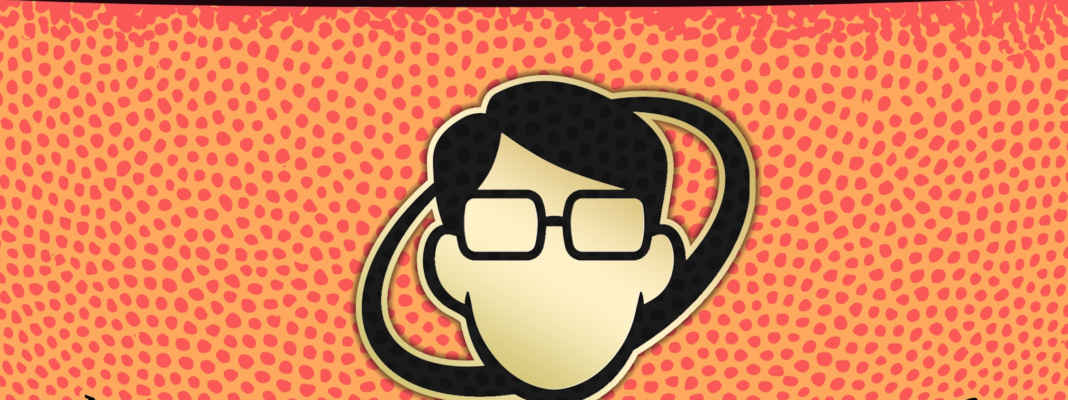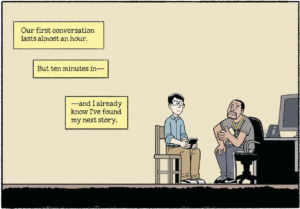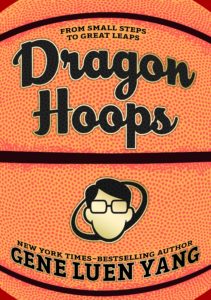
When I was growing up, I was never into sports that much. Although I tried my hand at them—T-ball, soccer, basketball, skateboarding, you name it—they were not for me. Reading was more my speed. But basketball… there was a spot in my heart for basketball, even if it was just for a little bit of time (had to support the Phoenix Suns, my hometown team!). But as the years went by, I really put any thoughts towards basketball on the back-burner. Sports, in general, didn’t thrill me. They still don’t.
But even if you’re averse to sports of any kind, or even find the whole spectacle of team sports to be ostentatious, your mind will be changed by Dragon Hoops (First Second), the thrilling and touching new graphic novel from Gene Luen Yang. Yang’s contribution to the comics medium is, by any standard, absolutely extraordinary (there’s not enough time to get into all of his works here. Just go and check them out!). But Dragon Hoops… there’s no way around it. Dragon Hoops is a truly special book. It’s a wonderful and enveloping quilt, a heartwarming and triumphant look at the redemptive power of basketball (in this case, high school basketball) to bring a community together. A personal memoir (a first from the author), a history, an underdog tale—Dragon Hoops spins multiple narratives with ease. I was fortunate to have a chance to chat with Yang about the book. Here follows our conversation.
AJ FROST: I wanted to start off by asking you about your headspace as you wrote Dragon Hoops. This graphic novel is such a contrast from your other comic work, so I wondered how you got into the process mentally. Was it different from your other books, or do you feel it was pretty much the same?
GENE LUEN YANG: I am on the faculty of Hamline University’s MFAC program. We’re a writing program for folks who are interested in writing for children and young adults. From time to time, one of my students will have a few different story ideas and they’ll ask me which idea they ought to pursue. I always tell them to go with the idea that scares them most.
That was Dragon Hoops for me. I’ve never done nonfiction before. I’ve never done a sports story before. I’ve never done a memoir before. This book ended up being all three. A lot of authors will say that, every time they begin a new book, they feel like novices again. That’s certainly true for me, especially with this book.
FROST: It’s so interesting to me that Dragon Hoops is a personal memoir, a history, a cultural memoir, and a sports story all wrapped into one tidy package. How did you manage to keep all the threads together in a way that was narratively satisfying?

YANG: I’m so glad you thought the different threads worked! I was really nervous about that. I didn’t mean for Dragon Hoops to have all those different elements when I first proposed the project to First Second. I imagined it would be about 200 pages long. I didn’t think it would have historical vignettes or endnotes or even me as a character. I wanted to focus solely on the players and the coaches.
In the end, though, I included historical vignettes, endnotes, and me as a character. And it grew to 448 pages.
I began reading books about basketball history because I wanted to better understand the game. I wasn’t planning on putting any of it in Dragon Hoops, but what I read was so interesting. It affected the way I watched the Dragons’ games. I discovered all these connections between what I was seeing on the court and what I had read. I read those books in part because I felt inadequate as a storyteller. I wasn’t a basketball player, even when I was a kid. I wasn’t a basketball fan. I had a lot of blind spots, and I felt I had to be real with the reader about those blind spots. The best way to do that was to include myself in the book.
I was very, very unsure about blending all those elements together. I had a lot of help. First Second has an informal, internal group of cartoonists called the Story Trust. Basically, a bunch of us get together on video conferences and critique each other’s work. The guidance of the Story Trust really helped me figure out the connections between the different parts of the book.
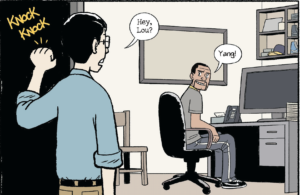
YANG: It’s been five years since the season that’s depicted in Dragon Hoops. Those kids aren’t kids anymore! They’re all adults now. Many of them have graduated from college. One is about to start medical school. One got drafted into the NBA.
I’m still in touch with a couple of them. Jeevin Sandhu and I text from time to time. He’s the main character of Chapter 8. Last semester, Arinze Chidom, one of main characters of Chapter 6, had to read my book Boxers and Saints for one of his college courses. He invited me to Skype into his class and I did. Then at the end of last year, I went to watch him and his team play against a local college. He absolutely dominated! It was thrilling to see.
FROST: What surprised you the most about this book as you were completing it? Was it a worthy journey for you (and the students at O’Dowd)?
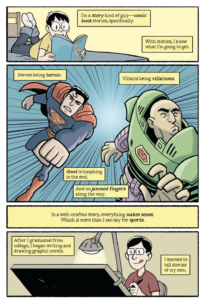
Lark and I had a conversation when we were nearing the finish line. I said, half-jokingly, that if I had known how much work it would be, I probably would never have started Dragon Hoops. She half-jokingly agreed. In the end, though, I do think it was a worthy journey. That season was unique in so many ways. Everyone involved will tell you that it was life-changing. I feel incredibly lucky to have been a part of it. I feel incredibly lucky that I got to put it down on paper.
FROST: What do you want readers to walk away with after finishing the book What reaction do you want them to feel?
YANG: The biggest lesson that I learned during that season is that sometimes, you have to step into uncertainty. That’s the big difference between sports and superhero stories, right? In superhero stories, you know from the first page that the hero is going to win. In sports, no matter how good your team is, the outcome isn’t guaranteed. There’s always a degree of uncertainty.
For a high school player, many of their most vivid memories ever are going to be made on that court. Some of those memories will bring them joy for the rest of their lives. Others will embarrass them. Those stakes are pretty high, especially for a teenager. Yet, as I saw over and over during that season, the kids step out anyway.
Right now, the world feels really uncertain. I hope my readers (and I) will remember that sometimes, we have to step out anyway.
Dragon Hoops is available tomorrow from First Second. As Yang’s book tour has been canceled due to COVID-19 concerns, he is doing a virtual book tour via Instagram.


